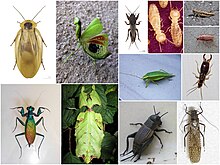| Polyneoptera | |
|---|---|

| |
| Some representatives | |
| Scientific classification | |
| Domain: | Eukaryota |
| Kingdom: | Animalia |
| Phylum: | Arthropoda |
| Class: | Insecta |
| (unranked): | Dicondylia |
| Subclass: | Pterygota |
| Infraclass: | Neoptera |
| Cohort: | Polyneoptera Martynov, 1923[1] |
| Orders | |
|
See text | |
| Synonyms | |
| |
The cohort Polyneoptera is one of the major groups of winged insects, comprising the Orthoptera (grasshoppers, crickets, etc.) and all other neopteran insects believed to be more closely related to Orthoptera than to any other insect orders. They were formerly grouped together with the Palaeoptera and Paraneoptera as the Hemimetabola or Exopterygota on the grounds that they have no metamorphosis, the wings gradually developing externally throughout the nymphal stages.[2] Many members of the group have leathery forewings (tegmina) and hindwings with an enlarged anal field (vannus).
Taxonomy[edit]
Extant[edit]
The following extant orders are included in Polyneoptera:[3]
- Superorder Dictyoptera
- Order Orthoptera (grasshoppers, crickets, katydids)
- Order Dermaptera (earwigs)
- Order Embioptera (web-spinners)
- Order Plecoptera (stoneflies)
- Order Notoptera
- Suborder Grylloblattodea (ice-crawlers)
- Suborder Mantophasmatodea (gladiators)
- Order Phasmatodea (stick and leaf insects)
- Order Zoraptera (angel insects)
Fossil[edit]
The following fossil groups are included in Polyneoptera:[3]
- Archaeorthoptera (Orthoptera and stem-group relatives)
- †Caloneurodea
- †Cnemidolestodea (= Cnemidolestida)[4][5]
- †Geraroptera
- †Titanoptera – Carboniferous to Triassic
- order Incertae sedis
- family †Cacurgidae Handlirsch, 1911
- family †Chresmodidae Haase, 1890[6]
- family †Permostridulidae Béthoux, Nel, Lapeyrie & Gand, 2003
- family †Protophasmatidae Brongniart, 1885
- genus †Chenxiella Liu, Ren & Prokop, 2009
- genus †Lobeatta Béthoux, 2005
- genus †Longzhua Gu, Béthoux & Ren, 2011
- genus †Nectoptilus Béthoux, 2005
- genus †Sinopteron Prokop & Ren, 2007
- Stem-group Phasmatodea
- †family Xiphopteridae Sharov 1968
- †family Prochresmodidae Vishnyakova 1980
- †family Aeroplanidae Tillyard 1918
- †family Cretophasmatidae Sharov 1968
- †family Aerophasmatidae Martynov, 1928
- Stem-group Dermaptera
- †"Grylloblattida" (Stem-group Grylloblattodea?)
- †Eoblattida
- †Paoliida[7]
- †Protorthoptera
- † family Magicivenidae[8]
Phylogeny[edit]
The following cladogram is based on the molecular phylogeny of Wipfler et al. 2019:[9]
| Polyneoptera |
| ||||||||||||||||||||||||||||||||||||||||||||||||
See also[edit]
References[edit]
- ^ Martynov, A. V. (1923). "О двух основных типах крыльев насекомых и их значении для общей классификаци насекомых" [On the two main types of insect wings and their significance for the general classification of insects]. Proceedings of the I All-Russian Congress of Zoologists, Anatomists and Histologists in Petrograd on 15–21 December 1922: 88–89.
- ^ Entomology Endopterygota. Royal Entomological Society. Retrieved 29 September 2020.
- ^ a b David Eades. "Polyneoptera". Polyneoptera Species File Online. Version 5.0/5.0. Retrieved 8 December 2023.
- ^ Nel, A.; Poschmann, M.J. (2021). "A new representative of the "orthopteroid" insect family Cnemidolestidae from the lower Permian of Germany". Acta Palaeontologica Polonica. 66 (3): 641–646. doi:10.4202/app.00879.2021.
- ^ Aristov, D. (2014). "Classification of the order Cnemidolestida (Insecta: Perlidea) with descriptions of new taxa". Far Eastern Entomologist. 277: 1–46.
- ^ Delclos; Nel; Azar; Bechly; Dunlop; Engel; Heads (2008). "The enigmatic Mesozoic insect taxon Chresmodidae (Polyneoptera): New palaeobiological and phylogenetic data, with the description of a new species from the Lower Cretaceous of Brazil". Neues Jahrbuch für Geologie und Paläontologie - Abhandlungen. 247 (3): 353–381. doi:10.1127/0077-7749/2008/0247-0353.
- ^ Jakub Prokop; Wieslaw Krzemiński; Ewa Krzemińska; Thomas Hörnschemeyer; Jan-Michael Ilger; Carsten Brauckmann; Philippe Grandcolas; André Nel (2014). "Late Palaeozoic Paoliida is the sister group of Dictyoptera (Insecta: Neoptera)". Journal of Systematic Palaeontology. 12 (5): 601–622. doi:10.1080/14772019.2013.823468. S2CID 84407734.
- ^ Yang, Hongru; Shih, Chungkun; Rasnitsyn, Alexandr P.; Ren, Dong; Gao, Taiping (January 2022). Labandeira, Conrad (ed.). "Early Cretaceous enigmatic insect group showing unique wing venations and antennal sensilla". Papers in Palaeontology. 8 (1). doi:10.1002/spp2.1402. ISSN 2056-2799.
- ^ Wipfler, Benjamin; Letsch, Harald; Frandsen, Paul B.; Kapli, Paschalia; Mayer, Christoph; Bartel, Daniela; Buckley, Thomas R.; Donath, Alexander; Edgerly-Rooks, Janice S.; Fujita, Mari; Liu, Shanlin (February 2019). "Evolutionary history of Polyneoptera and its implications for our understanding of early winged insects". Proceedings of the National Academy of Sciences. 116 (8): 3024–3029. Bibcode:2019PNAS..116.3024W. doi:10.1073/pnas.1817794116. PMC 6386694. PMID 30642969.
External links[edit]
 Media related to Polyneoptera at Wikimedia Commons
Media related to Polyneoptera at Wikimedia Commons